MENU
The Electronic Scholarly Publishing Project: Providing access to classic scientific papers and other scholarly materials, since 1993. More About: ESP | OUR CONTENT | THIS WEBSITE | WHAT'S NEW | WHAT'S HOT
Comparative Timelines
The ESP Timeline (one of the site's most popular features) has been completely updated to allow the user to select (using the timeline controls above each column) different topics for the left and right sides of the display.
Select:
New Left Column
New Left Column
Dates
Decade
New Right Column
New Right Column
 Thomas Wedgwood conceives of making permanent pictures of camera images by using a durable surface coated with a light-sensitive chemical. He succeeds only in producing silhouettes and other shadow images, and is unable to make them permanent.
Thomas Wedgwood conceives of making permanent pictures of camera images by using a durable surface coated with a light-sensitive chemical. He succeeds only in producing silhouettes and other shadow images, and is unable to make them permanent.
1800
First performance of Ludwig von Beethoven's 1st Symphony in C.
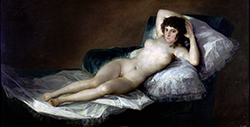 Painting by Francisco de Goya: The Nude Maja (Spanish: La Maja Desnuda) portrays a nude woman reclining on a bed of pillows, and was probably commissioned by Manuel de Godoy, to hang in his private collection in a separate cabinet reserved for nude paintings. Goya created a pendant of the same woman identically posed, but clothed, known today as La maja vestida (The Clothed Maja); also in the Prado, it is usually hung next to La maja desnuda. The subject is identified as a maja based on her costume in La maja vestida. The painting is renowned for the straightforward and unashamed gaze of the model towards the viewer. With this work Goya not only upset the ecclesiastical authorities, but also titillated the public and extended the artistic horizon of the day. It has been in the Museo del Prado in Madrid since 1901.
Painting by Francisco de Goya: The Nude Maja (Spanish: La Maja Desnuda) portrays a nude woman reclining on a bed of pillows, and was probably commissioned by Manuel de Godoy, to hang in his private collection in a separate cabinet reserved for nude paintings. Goya created a pendant of the same woman identically posed, but clothed, known today as La maja vestida (The Clothed Maja); also in the Prado, it is usually hung next to La maja desnuda. The subject is identified as a maja based on her costume in La maja vestida. The painting is renowned for the straightforward and unashamed gaze of the model towards the viewer. With this work Goya not only upset the ecclesiastical authorities, but also titillated the public and extended the artistic horizon of the day. It has been in the Museo del Prado in Madrid since 1901.
 Between 1800 and 1803, naturalist Alexander von Humboldt visits Mexico and writes influential accounts of his observations.
Between 1800 and 1803, naturalist Alexander von Humboldt visits Mexico and writes influential accounts of his observations.
 Karl Friedrich Burdach coins the term BIOLOGY to denote the study of human morphology, physiology and psychology.
Karl Friedrich Burdach coins the term BIOLOGY to denote the study of human morphology, physiology and psychology.
Erasmus Darwin publishes Phytologia declaring that leaves breathe air through tiny pores, sugar and starch are the products of plant "digestion," and nitrates and phosphorus promote vegetation.
 Alessandro Volta announces his invention, made in 1799, of the electric battery, also known as the Voltaic pile. It consists of a stack of alternating zinc and silver discs separated by felt soaked in brine. It is the first source of a steady electric current.
Alessandro Volta announces his invention, made in 1799, of the electric battery, also known as the Voltaic pile. It consists of a stack of alternating zinc and silver discs separated by felt soaked in brine. It is the first source of a steady electric current.
 William Herschel's "An investigation of the powers of prismatic colors to heat and illuminate objects" tells of his discovery of infrared radiation. While investigating the power of different parts of the spectrum to heat a thermometer, he finds that invisible light beyond the red produces the most heat.
William Herschel's "An investigation of the powers of prismatic colors to heat and illuminate objects" tells of his discovery of infrared radiation. While investigating the power of different parts of the spectrum to heat a thermometer, he finds that invisible light beyond the red produces the most heat.
(no entry for this year)
1801
 Thomas Jefferson becomes the third president of the United States.
Thomas Jefferson becomes the third president of the United States.
Ireland and Great Britain, England and Scotland, form United Kingdom.
 Giuseppe Piazzi discovers first asteroid, which is later named Ceres.
Giuseppe Piazzi discovers first asteroid, which is later named Ceres.
 Jean-Baptiste Lamarck's Système de Animaux sans Vertèbres (System for Animals without Vertebrae) includes a classification system for invertebrates and a preliminary view of his ideas of evolution.
Jean-Baptiste Lamarck's Système de Animaux sans Vertèbres (System for Animals without Vertebrae) includes a classification system for invertebrates and a preliminary view of his ideas of evolution.
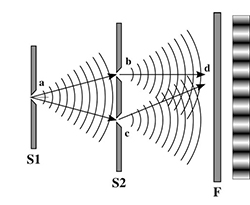 The English scientist Thomas Young demonstrates, in his famous double-slit experiment, the interference of light and concludes that light is a wave, not a particle as Sir Isaac Newton had ruled.
The English scientist Thomas Young demonstrates, in his famous double-slit experiment, the interference of light and concludes that light is a wave, not a particle as Sir Isaac Newton had ruled.
(no entry for this year)
1802
The Ohio Constitution outlaws slavery. It also prohibits free blacks from voting.
In Natural Theology, William Paley uses the analogy of a watch requiring a watchmaker to argue that the universe implies an intelligent designer.

 Gottfried Treviranus and Jean Baptiste de Lamarck independently broaden the meaning of BIOLOGY to include the study of all living things.
Gottfried Treviranus and Jean Baptiste de Lamarck independently broaden the meaning of BIOLOGY to include the study of all living things.
 Considered the father of modern scientific education in America, Benjamin Silliman, Sr., teaches the first modern science course (chemistry at Yale) in the United States. Silliman later becomes a founder in 1818 of the American Journal of Science, one of the oldest scientific journals in the world.
Considered the father of modern scientific education in America, Benjamin Silliman, Sr., teaches the first modern science course (chemistry at Yale) in the United States. Silliman later becomes a founder in 1818 of the American Journal of Science, one of the oldest scientific journals in the world.
 Thomas Young's On the theory of light and colors is the first of three pivotal papers describing his wave theory of light.
Thomas Young's On the theory of light and colors is the first of three pivotal papers describing his wave theory of light.
(no entry for this year)
1803
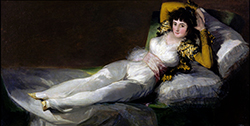 Painting by Francisco de Goya: The Clothed Maja (Spanish: La maja vestida) is a clothed version of the earlier La maja desnuda (1797–1800) and is exhibited next to it in the same room at the Prado Museum in Madrid. It was twice in the collection of the Royal Academy of Fine Arts of San Fernando, also in Madrid, being "sequestered" by the Spanish Inquisition between 1814 and 1836, and has been in the Museo del Prado since 1901.
Painting by Francisco de Goya: The Clothed Maja (Spanish: La maja vestida) is a clothed version of the earlier La maja desnuda (1797–1800) and is exhibited next to it in the same room at the Prado Museum in Madrid. It was twice in the collection of the Royal Academy of Fine Arts of San Fernando, also in Madrid, being "sequestered" by the Spanish Inquisition between 1814 and 1836, and has been in the Museo del Prado since 1901.
U.S. President Thomas Jefferson appoints Meriwether Lewis and William Clark to explore the uncharted West. Among the marvels Lewis and Clark are expected to find are erupting volcanoes, mountains of salt, unicorns, living mastodons and seven-foot-tall beavers. They will find none of these, but will find fossils.
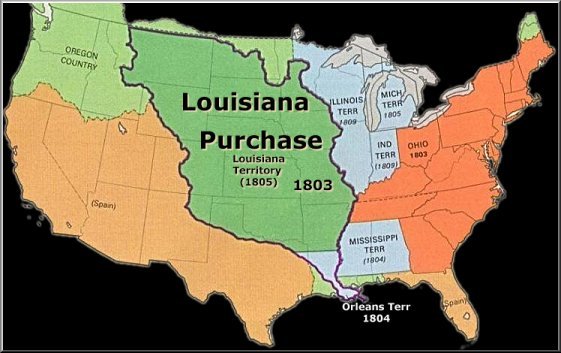 US buys large tract of land from France — The Louisiana Purchase.
US buys large tract of land from France — The Louisiana Purchase.
(no entry for this year)
1804

 Meriwether Lewis and William Clark begin their exploration of the Louisiana territory.
Meriwether Lewis and William Clark begin their exploration of the Louisiana territory.
Georges Cuvier suggests that fossils found in the area around Paris are "thousands of centuries" old. This casual observation pushes the age of the Earth well beyond its commonly accepted limits. Cuvier also publishes a paper explaining that the fossil animals he has studied bear no resemblance to anything still living, an unambiguous endorsement of the theory of extinction.
James Parkinson publishes the first of a three-volume work entitled Organic Remains of a Former World. In this volume, he describes fossils as the remains of Noah's Flood. In the next several years, he will recognize fossils as the remains of a world before people, and acknowledge as much in the third volume, published in 1811.
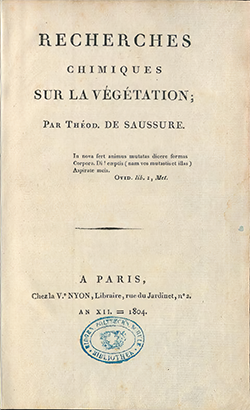 Nicolas-Théodore de Saussure's Recherches chimiques sur la végétation "Chemical researches on vegetation" shows that plants require carbon dioxide from the air and nitrogen from the soil. Earlier researchers had assumed the plants got carbon from the soil instead of from the air.
Nicolas-Théodore de Saussure's Recherches chimiques sur la végétation "Chemical researches on vegetation" shows that plants require carbon dioxide from the air and nitrogen from the soil. Earlier researchers had assumed the plants got carbon from the soil instead of from the air.
John Leslie's An experimental inquiry into the nature and propagation of heat establishes that the transmission of heat through radiation has the same properties as the propagation of light.
(no entry for this year)
1805
 Britain's Lord Nelson defeats the Franco-Spanish fleet at the Battle of Trafalgar. Lord Nelson is killed, but his victory ends Napoleons power at sea and makes a French invasion of Britain impossible.
Britain's Lord Nelson defeats the Franco-Spanish fleet at the Battle of Trafalgar. Lord Nelson is killed, but his victory ends Napoleons power at sea and makes a French invasion of Britain impossible.
 The field of comparative anatomy begins, with the publications of Baron Georges Cuvier's Lesson in Comparative Anatomy
The field of comparative anatomy begins, with the publications of Baron Georges Cuvier's Lesson in Comparative Anatomy
 Pierre-Simon Laplace measures molecular forces in liquids and announces his theory of capillary forces.
Pierre-Simon Laplace measures molecular forces in liquids and announces his theory of capillary forces.
The English chemist John Dalton develops his atomic theory, proposing that each chemical element is composed of atoms of a single unique type, and that, though they are both immutable and indestructible, they can combine to form more complex structures.
(no entry for this year)
1806
(no entry for this year)
(no entry for this year)
1807
The Slave Trade Act 1807 or the Abolition of the Slave Trade Act 1807, was an Act of the Parliament of the United Kingdom passed on 25 March 1807, with the title of "An Act for the Abolition of the Slave Trade". The original act is in the Parliamentary Archives. The act abolished the slave trade in the British Empire, in particular the Atlantic slave trade, and also encouraged British action to press other European states to abolish their slave trades, but it did not abolish slavery itself.
 Robert Fulton develops the first practical steamboat, the Clermont, which sails from New York City to Albany and back.
Robert Fulton develops the first practical steamboat, the Clermont, which sails from New York City to Albany and back.
 Thomas Young introduces the concept of, and is the first to use the word, ENERGY.
Thomas Young introduces the concept of, and is the first to use the word, ENERGY.
(no entry for this year)
1808
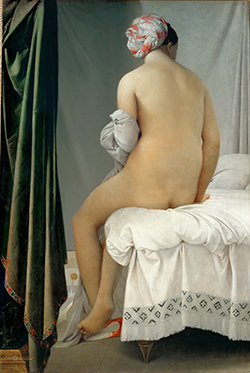 Painting by Jean-Auguste-Dominique Ingres: The Valpincon Bather, painted while the artist was studying at the French Academy in Rome, it was originally titled Seated Woman but later became known after one of its nineteenth-century owners. Ingres had earlier painted female nudes, such as his Bathing Woman of 1807, yet this work is widely regarded as his first great treatment of the subject. As in the previous smaller work, the model is shown from behind; however, The Valpincon Bather lacks the earlier painting's overt sexuality, instead depicting a calm and measured sensuality.
Painting by Jean-Auguste-Dominique Ingres: The Valpincon Bather, painted while the artist was studying at the French Academy in Rome, it was originally titled Seated Woman but later became known after one of its nineteenth-century owners. Ingres had earlier painted female nudes, such as his Bathing Woman of 1807, yet this work is widely regarded as his first great treatment of the subject. As in the previous smaller work, the model is shown from behind; however, The Valpincon Bather lacks the earlier painting's overt sexuality, instead depicting a calm and measured sensuality.
United States Bans Slave Trade Importing African slaves is outlawed, but smuggling continues.
The US prohibits the importation of new slaves from Africa (but the holding of existing slaves and their descendents remains legal).
 Étienne-Louis Malus discovers that reflected light is polarized and introduces the term POLARIZATION.
Étienne-Louis Malus discovers that reflected light is polarized and introduces the term POLARIZATION.
(no entry for this year)
1809
 12 Feb 1809
12 Feb 1809
Abraham Lincoln is born
 12 Feb 1809
12 Feb 1809
Charles Darwin is born
 James Madison becomes the fourth president of the United States.
James Madison becomes the fourth president of the United States.
 Jean Baptiste de Lamarck's theory of evolution presented with the publication of his Philosophie Zoologique, which emphasized the fundamental unity of life and the capacity of species to vary.
Jean Baptiste de Lamarck's theory of evolution presented with the publication of his Philosophie Zoologique, which emphasized the fundamental unity of life and the capacity of species to vary.
ESP Quick Facts
ESP Origins
In the early 1990's, Robert Robbins was a faculty member at Johns Hopkins, where he directed the informatics core of GDB — the human gene-mapping database of the international human genome project. To share papers with colleagues around the world, he set up a small paper-sharing section on his personal web page. This small project evolved into The Electronic Scholarly Publishing Project.
ESP Support
In 1995, Robbins became the VP/IT of the Fred Hutchinson Cancer Research Center in Seattle, WA. Soon after arriving in Seattle, Robbins secured funding, through the ELSI component of the US Human Genome Project, to create the original ESP.ORG web site, with the formal goal of providing free, world-wide access to the literature of classical genetics.
ESP Rationale
Although the methods of molecular biology can seem almost magical to the uninitiated, the original techniques of classical genetics are readily appreciated by one and all: cross individuals that differ in some inherited trait, collect all of the progeny, score their attributes, and propose mechanisms to explain the patterns of inheritance observed.
ESP Goal
In reading the early works of classical genetics, one is drawn, almost inexorably, into ever more complex models, until molecular explanations begin to seem both necessary and natural. At that point, the tools for understanding genome research are at hand. Assisting readers reach this point was the original goal of The Electronic Scholarly Publishing Project.
ESP Usage
Usage of the site grew rapidly and has remained high. Faculty began to use the site for their assigned readings. Other on-line publishers, ranging from The New York Times to Nature referenced ESP materials in their own publications. Nobel laureates (e.g., Joshua Lederberg) regularly used the site and even wrote to suggest changes and improvements.
ESP Content
When the site began, no journals were making their early content available in digital format. As a result, ESP was obliged to digitize classic literature before it could be made available. For many important papers — such as Mendel's original paper or the first genetic map — ESP had to produce entirely new typeset versions of the works, if they were to be available in a high-quality format.
ESP Help
Early support from the DOE component of the Human Genome Project was critically important for getting the ESP project on a firm foundation. Since that funding ended (nearly 20 years ago), the project has been operated as a purely volunteer effort. Anyone wishing to assist in these efforts should send an email to Robbins.
ESP Plans
With the development of methods for adding typeset side notes to PDF files, the ESP project now plans to add annotated versions of some classical papers to its holdings. We also plan to add new reference and pedagogical material. We have already started providing regularly updated, comprehensive bibliographies to the ESP.ORG site.
ESP Picks from Around the Web (updated 06 MAR 2017 )
Old Science

Weird Science

Treating Disease with Fecal Transplantation
Fossils of miniature humans (hobbits) discovered in Indonesia

Dinosaur tail, complete with feathers, found preserved in amber.
Astronomy

Mysterious fast radio burst (FRB) detected in the distant universe.